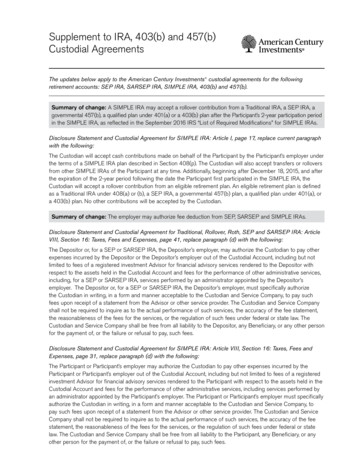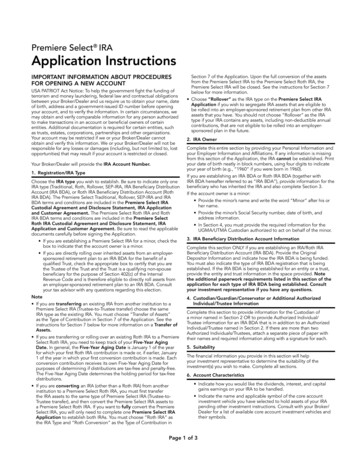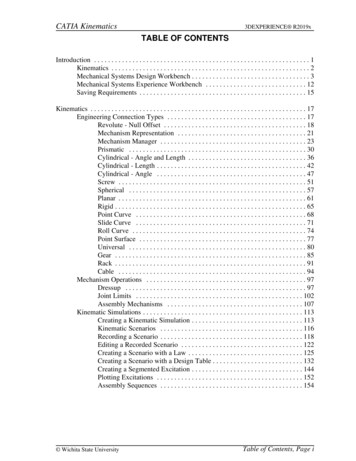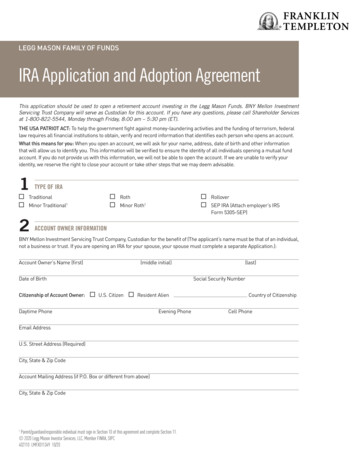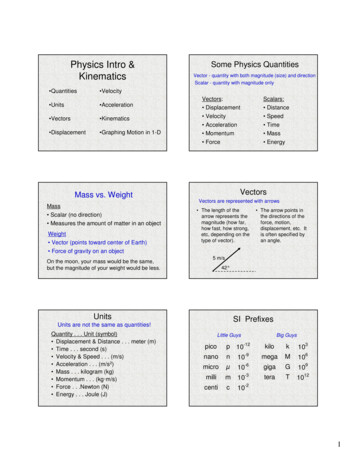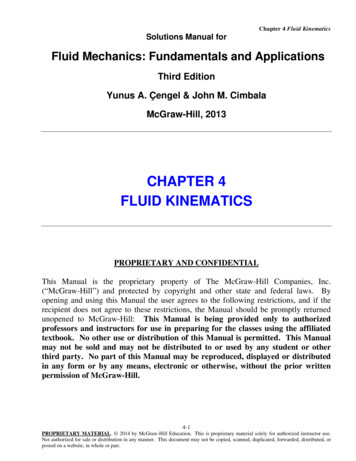
Transcription
Chapter 4 Fluid KinematicsSolutions Manual forFluid Mechanics: Fundamentals and ApplicationsThird EditionYunus A. Çengel & John M. CimbalaMcGraw-Hill, 2013CHAPTER 4FLUID KINEMATICSPROPRIETARY AND CONFIDENTIALThis Manual is the proprietary property of The McGraw-Hill Companies, Inc.(“McGraw-Hill”) and protected by copyright and other state and federal laws. Byopening and using this Manual the user agrees to the following restrictions, and if therecipient does not agree to these restrictions, the Manual should be promptly returnedunopened to McGraw-Hill: This Manual is being provided only to authorizedprofessors and instructors for use in preparing for the classes using the affiliatedtextbook. No other use or distribution of this Manual is permitted. This Manualmay not be sold and may not be distributed to or used by any student or otherthird party. No part of this Manual may be reproduced, displayed or distributedin any form or by any means, electronic or otherwise, without the prior writtenpermission of McGraw-Hill.4-1PROPRIETARY MATERIAL. 2014 by McGraw-Hill Education. This is proprietary material solely for authorized instructor use.Not authorized for sale or distribution in any manner. This document may not be copied, scanned, duplicated, forwarded, distributed, orposted on a website, in whole or part.
Chapter 4 Fluid KinematicsIntroductory Problems4-1CSolutionWe are to define and explain kinematics and fluid kinematics.AnalysisKinematics means the study of motion. Fluid kinematics is the study of how fluids flow and how todescribe fluid motion. Fluid kinematics deals with describing the motion of fluids without considering (or evenunderstanding) the forces and moments that cause the motion.DiscussionFluid kinematics deals with such things as describing how a fluid particle translates, distorts, and rotates,and how to visualize flow fields.4-2CSolutionWe are to discuss the difference between derivative operators d and .AnalysisDerivative operator d is a total derivative, and implies that the dependent variable is a function of onlyone independent variable. On the other hand, derivative operator is a partial derivative, and implies that thedependent variable is a function of more than one independent variable. When u/ x appears in an equation, weimmediately know that u is a function of x and at least one other independent variable.DiscussionIn our study of fluid mechanics, velocity is usually a function of more than one variable, although for somesimple problems, we approximate it as a function of only one variable so that the problem can be solved analytically.4-3SolutionWe are to write an equation for centerline speed through a nozzle, given that the flow speed increasesparabolically.Assumptions1 The flow is steady. 2 The flow is axisymmetric. 3 The water is incompressible.AnalysisA general equation for a parabola in the x direction isGeneral parabolic equation:u a b x c 2(1)We have two boundary conditions, namely at x 0, u uentrance and at x L, u uexit. By inspection, Eq. 1 is satisfied bysetting c 0, a uentrance and b (uexit - uentrance)/L2. Thus, Eq. 1 becomesParabolic speed:Discussionu uentrance uexit uentrance L2x2(2)You can verify Eq. 2 by plugging in x 0 and x L.4-2PROPRIETARY MATERIAL. 2014 by McGraw-Hill Education. This is proprietary material solely for authorized instructor use.Not authorized for sale or distribution in any manner. This document may not be copied, scanned, duplicated, forwarded, distributed, orposted on a website, in whole or part.
Chapter 4 Fluid Kinematics4-4Solutionlocation.For a given velocity field we are to find out if there is a stagnation point. If so, we are to calculate itsAssumptions1 The flow is steady. 2 The flow is two-dimensional in the x-y plane.AnalysisThe velocity field is 2 V u, v a 2 b cx i 2cby 2c 2 xy j (1)At a stagnation point, both u and v must equal zero. At any point (x,y) in the flow field, the velocity components u and v areobtained from Eq. 1,Velocity components:u a 2 b cx 2v 2cby 2c 2 xy(2)b acy 0(3)Setting these to zero and solving simultaneously yieldsStagnation point:0 a 2 b cx 2x v 2cby 2c xy2So, yes there is a stagnation point; its location is x (b – a)/c, y 0.DiscussionIf the flow were three-dimensional, we would have to set w 0 as well to determine the location of thestagnation point. In some flow fields there is more than one stagnation point.4-5Solutionlocation.For a given velocity field we are to find out if there is a stagnation point. If so, we are to calculate itsAssumptions1 The flow is steady. 2 The flow is two-dimensional in the x-y plane.AnalysisThe velocity field is V u , v 0.781 4.67 x i 3.54 4.67 y j(1)At a stagnation point, both u and v must equal zero. At any point (x,y) in the flow field, the velocity components u and v areobtained from Eq. 1,Velocity components:u 0.781 4.67 xv 3.54 4.67 y(2)x 0.16724y 0.75803(3)Setting these to zero yieldsStagnation point:0 0.781 4.67 x0 3.54 4.67 ySo, yes there is a stagnation point; its location is x -0.167, y 0.758 (to 3 digits).DiscussionIf the flow were three-dimensional, we would have to set w 0 as well to determine the location of thestagnation point. In some flow fields there is more than one stagnation point.4-3PROPRIETARY MATERIAL. 2014 by McGraw-Hill Education. This is proprietary material solely for authorized instructor use.Not authorized for sale or distribution in any manner. This document may not be copied, scanned, duplicated, forwarded, distributed, orposted on a website, in whole or part.
Chapter 4 Fluid Kinematics4-6Solutionlocation.For a given velocity field we are to find out if there is a stagnation point. If so, we are to calculate itsAssumptions1 The flow is steady. 2 The flow is two-dimensional in the x-y plane.AnalysisThe velocity field is V (u , v) (0.66 2.1x )i ( 2.7 2.1y ) j(1)At a stagnation point, both u and v must equal zero. At any point (x,y) in the flow field, the velocity components u and v areobtained from Eq. 1,Velocity components:Stagnation point:u 0.66 2.1xv 2.7 2.1y0 0.66 2.1xx 0.3140 2.7 2.1 yy 1.29(2)(3)So, yes there is a stagnation point; its location is x -0.314, y -1.29 (to 3 digits).DiscussionIf the flow were three-dimensional, we would have to set w 0 as well to determine the location of thestagnation point. In some flow fields there is more than one stagnation point.Lagrangian and Eulerian Descriptions4-7CSolutiondescription.We are to define the Eulerian description of fluid motion, and explain how it differs from the LagrangianAnalysisIn the Eulerian description of fluid motion, we are concerned with field variables, such as velocity,pressure, temperature, etc., as functions of space and time within a flow domain or control volume. In contrast to theLagrangian method, fluid flows into and out of the Eulerian flow domain, and we do not keep track of the motion ofparticular identifiable fluid particles.DiscussionThe Eulerian method of studying fluid motion is not as “natural” as the Lagrangian method since thefundamental conservation laws apply to moving particles, not to fields.4-8CSolutionWe are to compare the Lagrangian method to the study of systems and control volumes and determine towhich of these it is most similar.AnalysisThe Lagrangian method is more similar to system analysis (i.e., closed system analysis). In both cases,we follow a mass of fixed identity as it moves in a flow. In a control volume analysis, on the other hand, mass moves intoand out of the control volume, and we don’t follow any particular chunk of fluid. Instead we analyze whatever fluidhappens to be inside the control volume at the time.Discussionto a point.In fact, the Lagrangian analysis is the same as a system analysis in the limit as the size of the system shrinks4-4PROPRIETARY MATERIAL. 2014 by McGraw-Hill Education. This is proprietary material solely for authorized instructor use.Not authorized for sale or distribution in any manner. This document may not be copied, scanned, duplicated, forwarded, distributed, orposted on a website, in whole or part.
Chapter 4 Fluid Kinematics4-9CSolutionWe are to define the Lagrangian description of fluid motion.AnalysisIn the Lagrangian description of fluid motion, individual fluid particles (fluid elements composed of afixed, identifiable mass of fluid) are followed.DiscussionThe Lagrangian method of studying fluid motion is similar to that of studying billiard balls and other solidobjects in physics.4-10CSolutionWe are to determine whether a measurement is Lagrangian or Eulerian.AnalysisSince the probe is fixed in space and the fluid flows around it, we are not following individual fluidparticles as they move. Instead, we are measuring a field variable at a particular location in space. Thus this is an Eulerianmeasurement.DiscussionIf a neutrally buoyant probe were to move with the flow, its results would be Lagrangian measurements –following fluid particles.4-11CSolutionWe are to determine whether a measurement is Lagrangian or Eulerian.AnalysisSince the probe moves with the flow and is neutrally buoyant, we are following individual fluid particles asthey move through the pump. Thus this is a Lagrangian measurement.DiscussionIf the probe were instead fixed at one location in the flow, its results would be Eulerian measurements.4-12CSolutionflow.We are to define a steady flow field in the Eulerian description, and discuss particle acceleration in such aAnalysisA flow field is defined as steady in the Eulerian frame of reference when properties at any point in theflow field do not change with respect to time. In such a flow field, individual fluid particles may still experience non-zeroacceleration – the answer to the question is yes.DiscussionAlthough velocity is not a function of time in a steady flow field, its total derivative with respect to time a dV / dt is not necessarily zero since the acceleration is composed of a local (unsteady) part which is zero and an advective part which is not necessarily zero.4-5PROPRIETARY MATERIAL. 2014 by McGraw-Hill Education. This is proprietary material solely for authorized instructor use.Not authorized for sale or distribution in any manner. This document may not be copied, scanned, duplicated, forwarded, distributed, orposted on a website, in whole or part.
Chapter 4 Fluid Kinematics4-13CSolutionWe are to list three alternate names for material derivative.AnalysisThe material derivative is also called total derivative, particle derivative, Eulerian derivative,Lagrangian derivative, and substantial derivative. “Total” is appropriate because the material derivative includes bothlocal (unsteady) and convective parts. “Particle” is appropriate because it stresses that the material derivative is onefollowing fluid particles as they move about in the flow field. “Eulerian” is appropriate since the material derivative is usedto transform from Lagrangian to Eulerian reference frames. “Lagrangian” is appropriate since the material derivative isused to transform from Lagrangian to Eulerian reference frames. Finally, “substantial” is not as clear of a term for thematerial derivative, and we are not sure of its origin.DiscussionAll of these names emphasize that we are following a fluid particle as it moves through a flow field.4-14CSolutionWe are to determine whether a measurement is Lagrangian or Eulerian.AnalysisSince the weather balloon moves with the air and is neutrally buoyant, we are following individual “fluidparticles” as they move through the atmosphere. Thus this is a Lagrangian measurement. Note that in this case the “fluidparticle” is huge, and can follow gross features of the flow – the balloon obviously cannot follow small scale turbulentfluctuations in the atmosphere.DiscussionWhen weather monitoring instruments are mounted on the roof of a building, the results are Eulerianmeasurements.4-15CSolutionWe are to determine whether a measurement is Lagrangian or Eulerian.AnalysisRelative to the airplane, the probe is fixed and the air flows around it. We are not following individual fluidparticles as they move. Instead, we are measuring a field variable at a particular location in space relative to the movingairplane. Thus this is an Eulerian measurement.DiscussionThe airplane is moving, but it is not moving with the flow.4-16CSolutionWe are to compare the Eulerian method to the study of systems and control volumes and determine towhich of these it is most similar.AnalysisThe Eulerian method is more similar to control volume analysis. In both cases, mass moves into and outof the flow domain or control volume, and we don’t follow any particular chunk of fluid. Instead we analyze whatever fluidhappens to be inside the control volume at the time.DiscussionIn fact, the Eulerian analysis is the same as a control volume analysis except that Eulerian analysis isusually applied to infinitesimal volumes and differential equations of fluid flow, whereas control volume analysis usuallyrefers to finite volumes and integral equations of fluid flow.4-6PROPRIETARY MATERIAL. 2014 by McGraw-Hill Education. This is proprietary material solely for authorized instructor use.Not authorized for sale or distribution in any manner. This document may not be copied, scanned, duplicated, forwarded, distributed, orposted on a website, in whole or part.
Chapter 4 Fluid Kinematics4-17SolutionWe are to calculate the material acceleration for a given velocity field.Assumptions1 The flow is steady. 2 The flow is incompressible. 3 The flow is two-dimensional in the x-y plane.AnalysisThe velocity field is V u , v U 0 bx i byj(1)The acceleration field components are obtained from its definition (the material acceleration) in Cartesian coordinates, u u u u u v w 0 U 0 bx b by 0 0 t x y z v v v vay u v w 0 U 0 bx 0 by b 0 t x y zax (2)where the unsteady terms are zero since this is a steady flow, and the terms with w are zero since the flow is twodimensional. Eq. 2 simplifies toax b U 0 bx Material acceleration components:ay b2 y(3) a b U 0 bx i b 2 yj(4)In terms of a vector,Material acceleration vector:DiscussionFor positive x and b, fluid particles accelerate in the positive x direction. Even though this flow is steady,there is still a non-zero acceleration field.4-18Solutionparticle.For a given pressure and velocity field, we are to calculate the rate of change of pressure following a fluidAssumptions1 The flow is steady. 2 The flow is incompressible. 3 The flow is two-dimensional in the x-y plane.AnalysisThe pressure field isP P0 Pressure field: 2U 0 bx b 2 x 2 y 2 2 (1)By definition, the material derivative, when applied to pressure, produces the rate of change of pressure following a fluidparticle. Using Eq. 1 and the velocity components from the previous problem, P PDP P u v x y tDt Steady Pw z (2)Two-dimensional U 0 bx U 0 b b 2 x by b 2 y where the unsteady term is zero since this is a steady flow, and the term with w is zero since the flow is two-dimensional.Eq. 2 simplifies to the following rate of change of pressure following a fluid particle: DP2 U 0 b 2U 0 b 2 x b3 y 2 x 2 Dt(3)DiscussionThe material derivative can be applied to any flow property, scalar or vector. Here we apply it to thepressure, a scalar quantity.4-7PROPRIETARY MATERIAL. 2014 by McGraw-Hill Education. This is proprietary material solely for authorized instructor use.Not authorized for sale or distribution in any manner. This document may not be copied, scanned, duplicated, forwarded, distributed, orposted on a website, in whole or part.
Chapter 4 Fluid Kinematics4-19SolutionFor a given velocity field we are to calculate the acceleration.Assumptions1 The flow is steady. 2 The flow is two-dimensional in the x-y plane.The velocity components areAnalysisVelocity components:u 1.85 2.33 x 0.656 yv 0.754 2.18 x 2.33 y(1)The acceleration field components are obtained from its definition (the material acceleration) in Cartesian coordinates, u u u u u v w 0 1.85 2.33 x 0.656 y 2.33 0.754 2.18 x 2.33 y 0.656 0 t x y z v v v v u v w 0 1.85 2.33 x 0.656 y 2.18 0.754 2.18 x 2.33 y 2.33 0ay t x y zax (2)where the unsteady terms are zero since this is a steady flow, and the terms with w are zero since the flow is twodimensional. Eq. 2 simplifies toAcceleration components:ax 4.8051 3.9988 xa y 5.7898 3.9988 y(3)At the point (x,y) (-1,2), the acceleration components of Eq. 3 areAcceleration components at (-1,2):ax 0.80628 0.806a y 2.2078 2.21DiscussionThe final answers are given to three significant digits. No units are given in either the problem statement orthe answers. We assume that the coefficients have appropriate units.4-8PROPRIETARY MATERIAL. 2014 by McGraw-Hill Education. This is proprietary material solely for authorized instructor use.Not authorized for sale or distribution in any manner. This document may not be copied, scanned, duplicated, forwarded, distributed, orposted on a website, in whole or part.
Chapter 4 Fluid Kinematics4-20SolutionFor a given velocity field we are to calculate the acceleration.Assumptions1 The flow is steady. 2 The flow is two-dimensional in the x-y plane.AnalysisThe velocity components areVelocity components:u 0.205 0.97 x 0.851 yv 0.509 0.953 x 0.97 y(1)The acceleration field components are obtained from its definition (the material acceleration) in Cartesian coordinates, u u u u v w 0 (0.205 0.97 x 0.851 y )(0.97) ( 0.509 0.953 x 0.97 y )(0.851) 0 u y z t x v v v vay u v w 0 (0.205 0.97 x 0.851 y )(0.953) ( 0.509 0.953 x 0.97 y )( 0.97) 0 t x y zax (2)where the unsteady terms are zero since this is a steady flow, and the terms with w are zero since the flow is twodimensional. Eq. 2 simplifies toAcceleration components:a x 0.234309 1.751903x(3)a y 0.689095 1.751903 yAt the point (x,y) (2, 1.5), the acceleration components of Eq. 3 areAcceleration components at (2, 1.5):a x 3.269497 3.27a y 3.31699 3.32DiscussionThe final answers are given to three significant digits. No units are given in either the problem statement orthe answers. We assume that the coefficients have appropriate units.4-9PROPRIETARY MATERIAL. 2014 by McGraw-Hill Education. This is proprietary material solely for authorized instructor use.Not authorized for sale or distribution in any manner. This document may not be copied, scanned, duplicated, forwarded, distributed, orposted on a website, in whole or part.
Chapter 4 Fluid Kinematics4-21SolutionAssumptionsAnalysisFor a given velocity field we are to calculate the streamline that will pass through a given point.1 The flow is steady. 2 The flow is three-dimensional in the x-y-z plane.dx dy dz uvwdxdydz 3x 2 y 2 zFor the first two pairs we havedxdy11 or ln x ln y ln c13x 2 y321x3 y 12 c1 or,For the point given x 1, y 1, z 01 11 3 .1 2 c1 c1 1 or3x y , y x2 3on the other hand,dx dx 11 or ln z ln x ln c2 z 3x 23z13z x c or 2 3 c z c.x 2 3xA 1,1,0 ,0 c.12 3 , c 0 or z 0Therefore the streamline is given by,y x2 3, z 04-22SolutionWe are to write an equation for centerline speed through a diffuser, given that the flow speed decreasesparabolically.Assumptions1 The flow is steady. 2 The flow is axisymmetric.AnalysisA general equation for a parabola in x isGeneral parabolic equation:u a b x c 2(1)We have two boundary conditions, namely at x 0, u uentrance and at x L, u uexit. By inspection, Eq. 1 is satisfied bysetting c 0, a uentrance and b (uexit - uentrance)/L2. Thus, Eq. 1 becomesParabolic speed:Discussionu uentrance uexit uentrance L2x2(2)You can verify Eq. 2 by plugging in x 0 and x L.4-10PROPRIETARY MATERIAL. 2014 by McGraw-Hill Education. This is proprietary material solely for authorized instructor use.Not authorized for sale or distribution in any manner. This document may not be copied, scanned, duplicated, forwarded, distributed, orposted on a website, in whole or part.
Chapter 4 Fluid Kinematics4-23SolutionWe are to generate an expression for the fluid acceleration for a given velocity, and then calculate its valueat two x locations.Assumptions1 The flow is steady. 2 The flow is axisymmetric.AnalysisIn the previous problem, we found that along the centerline,u uentrance Speed along centerline of diffuser: uexit uentrance x2(1) u u u u w u v z t x y(2)L2To find the acceleration in the x-direction, we use the material acceleration,ax Acceleration along centerline of diffuser:The first term in Eq. 2 is zero because the flow is steady. The last two terms are zero because the flow is axisymmetric,which means that along the centerline there can be no v or w velocity component. We substitute Eq. 1 for u to obtainAcceleration along centerline of diffuser: ax u uexit uentrance 2 uexit uentrance u uentrance x 2 x x L2L2 orax 2uentrance uexit uentrance L2x 2 uexit uentrance L42(3)x3At the given locations, we substitute the given values. At x 0,Acceleration along centerline of diffuser at x 0:ax x 0 0(4)At x 1.0 m,Acceleration along centerline of diffuser at x 1.0 m: 7.5 m/s 7.5 m/s 3ax x 1.0 m 2 24.3 m/s 1.0 m 21.0 m 2 4 1.56 m 1.56 m 2(5) 130.782 m/s 2 -131 m/s 2Discussionax is negative implying that fluid particles are decelerated along the centerline of the diffuser, even thoughthe flow is steady. Because of the parabolic nature of the velocity field, the acceleration is zero at the entrance of thediffuser, but its magnitude increases rapidly downstream.4-11PROPRIETARY MATERIAL. 2014 by McGraw-Hill Education. This is proprietary material solely for authorized instructor use.Not authorized for sale or distribution in any manner. This document may not be copied, scanned, duplicated, forwarded, distributed, orposted on a website, in whole or part.
Chapter 4 Fluid Kinematics4-24SolutionFor a given velocity field we are to calculate the acceleration.Assumptions1 The flow is steady. 2 The flow is two-dimensional in the x-y plane.The velocity components areAnalysisVelocity components:u 0.523 1.88 x 3.94 yv 2.44 1.26 x 1.88 y(1)The acceleration field components are obtained from its definition (the material acceleration) in Cartesian coordinates, u u u u u v w 0 0.523 1.88 x 3.94 y 1.88 2.44 1.26 x 1.88 y 3.94 0 t x y z v v v vay u v w 0 0.523 1.88 x 3.94 y 1.26 2.44 1.26 x 1.88 y 1.88 0 t x y zax (2)where the unsteady terms are zero since this is a steady flow, and the terms with w are zero since the flow is twodimensional. Eq. 2 simplifies toAcceleration components:ax 10.59684 8.4988 xa y 3.92822 8.4988 y(3)At the point (x,y) (-1.55, 2.07), the acceleration components of Eq. 3 areAcceleration components at (-1.55, 2.07):ax 23.76998 -23.8a y 13.6643 13.7DiscussionThe final answers are given to three significant digits. No units are given in either the problem statement orthe answers. We assume that the coefficients have appropriate units.4-25SolutionWe are to generate an expression for the fluid acceleration for a given velocity.Assumptions1 The flow is steady. 2 The flow is axisymmetric. 3 The water is incompressible.AnalysisIn Problem 4-2 we found that along the centerline,u uentrance Speed along centerline of nozzle: uexit uentrance x2(1) u u u u w u v z t x y(2)2LTo find the acceleration in the x-direction, we use the material acceleration,ax Acceleration along centerline of nozzle:The first term in Eq. 2 is zero because the flow is steady. The last two terms are zero because the flow is axisymmetric,which means that along the centerline there can be no v or w velocity component. We substitute Eq. 1 for u to obtainAcceleration along centerline of nozzle:ax u uexit uentrance 2 uexit uentrance u x 2 x uentrance x L2L2 (3)orax 2uentranceDiscussion uexit uentrance L2x 2 uexit uentrance L42x3(4)Fluid particles are accelerated along the centerline of the nozzle, even though the flow is steady.4-12PROPRIETARY MATERIAL. 2014 by McGraw-Hill Education. This is proprietary material solely for authorized instructor use.Not authorized for sale or distribution in any manner. This document may not be copied, scanned, duplicated, forwarded, distributed, orposted on a website, in whole or part.
Chapter 4 Fluid KinematicsFlow Patterns and Flow Visualization4-26CSolutionWe are to define pathline and discuss what pathlines indicate.AnalysisA pathline is the actual path traveled by an individual fluid particle over some time period. It indicatesthe exact route along which a fluid particle travels from its starting point to its ending point. Unlike streamlines, pathlinesare not instantaneous, but involve a finite time period.DiscussionIf a flow field is steady, streamlines, pathlines, and streaklines are identical.4-27CSolutionWe are to determine what kind of flow visualization is seen in a photograph.AnalysisSince the picture is a snapshot of dye streaks in water, each streak shows the time history of dye that wasintroduced earlier from a port in the body. Thus these are streaklines. Since the flow appears to be steady, these streaklinesare the same as pathlines and streamlines.DiscussionIt is assumed that the dye follows the flow of the water. If the dye is of nearly the same density as the water,this is a reasonable assumption.4-28CSolutionWe are to define streamline and discuss what streamlines indicate.AnalysisA streamline is a curve that is everywhere tangent to the instantaneous local velocity vector. Itindicates the instantaneous direction of fluid motion throughout the flow field.DiscussionIf a flow field is steady, streamlines, pathlines, and streaklines are identical.4-29CSolutionWe are to define streakline and discuss the difference between streaklines and streamlines.AnalysisA streakline is the locus of fluid particles that have passed sequentially through a prescribed point inthe flow. Streaklines are very different than streamlines. Streamlines are instantaneous curves, everywhere tangent to thelocal velocity, while streaklines are produced over a finite time period. In an unsteady flow, streaklines distort and thenretain features of that distorted shape even as the flow field changes, whereas streamlines change instantaneously with theflow field.DiscussionIf a flow field is steady, streamlines and streaklines are identical.4-30CSolutionWe are to determine what kind of flow visualization is seen in a photograph.AnalysisSince the picture is a snapshot of dye streaks in water, each streak shows the time history of dye that wasintroduced earlier from a port in the body. Thus these are streaklines. Since the flow appears to be unsteady, thesestreaklines are not the same as pathlines or streamlines.DiscussionIt is assumed that the dye follows the flow of the water. If the dye is of nearly the same density as the water,this is a reasonable assumption.4-13PROPRIETARY MATERIAL. 2014 by McGraw-Hill Education. This is proprietary material solely for authorized instructor use.Not authorized for sale or distribution in any manner. This document may not be copied, scanned, duplicated, forwarded, distributed, orposted on a website, in whole or part.
Chapter 4 Fluid Kinematics4-31CSolutionWe are to determine what kind of flow visualization is seen in a photograph.AnalysisSince the picture is a snapshot of smoke streaks in air, each streak shows the time history of smoke that wasintroduced earlier from the smoke wire. Thus these are streaklines. Since the flow appears to be unsteady, these streaklinesare not the same as pathlines or streamlines.DiscussionIt is assumed that the smoke follows the flow of the air. If the smoke is neutrally buoyant, this is areasonable assumption. In actuality, the smoke rises a bit since it is hot; however, the air speeds are high enough that thiseffect is negligible.4-32CSolutionWe are to determine what kind of flow visualization is seen in a photograph.AnalysisSince the picture is a time exposure of air bubbles in water, each white streak shows the path of anindividual air bubble. Thus these are pathlines. Since the outer flow (top and bottom portions of the photograph) appears tobe steady, these pathlines are the same as streaklines and streamlines.DiscussionIt is assumed that the air bubbles follow the flow of the water. If the bubbles are small enough, this is areasonable assumption.4-33CSolutionWe are to define timeline and discuss how timelines can be produced in a water channel. We are also todescribe an application where timelines are more useful than streaklines.AnalysisA timeline is a set of adjacent fluid particles that were marked at the same instant of time. Timelinescan be produced in a water flow by using a hydrogen bubble wire. There are also techniques in which a chemical reaction isinitiated by applying current to the wire, changing the fluid color along the wire. Timelines are more useful than streaklineswhen the uniformity of a flow is to be visualized. Another application is to visualize the velocity profile of a boundary layeror a channel flow.DiscussionTimelines differ from streamlines, streaklines, and pathlines even if the flow is steady.4-34CSolutionFor each case we are to decide whether a vector plot or contour plot is most appropriate, and we are toexplain our choice.AnalysisIn general, contour plots are most appropriate for scalars, while vector plots are necessary w
Solution We are to define and explain kinematics and fluid kinematics. Analysis Kinematics means the study of motion. Fluid kinematics is the study of how fluids flow and how to describe fluid motion. Fluid kinematics deals with describing the motion of fluids without considering (or even und

